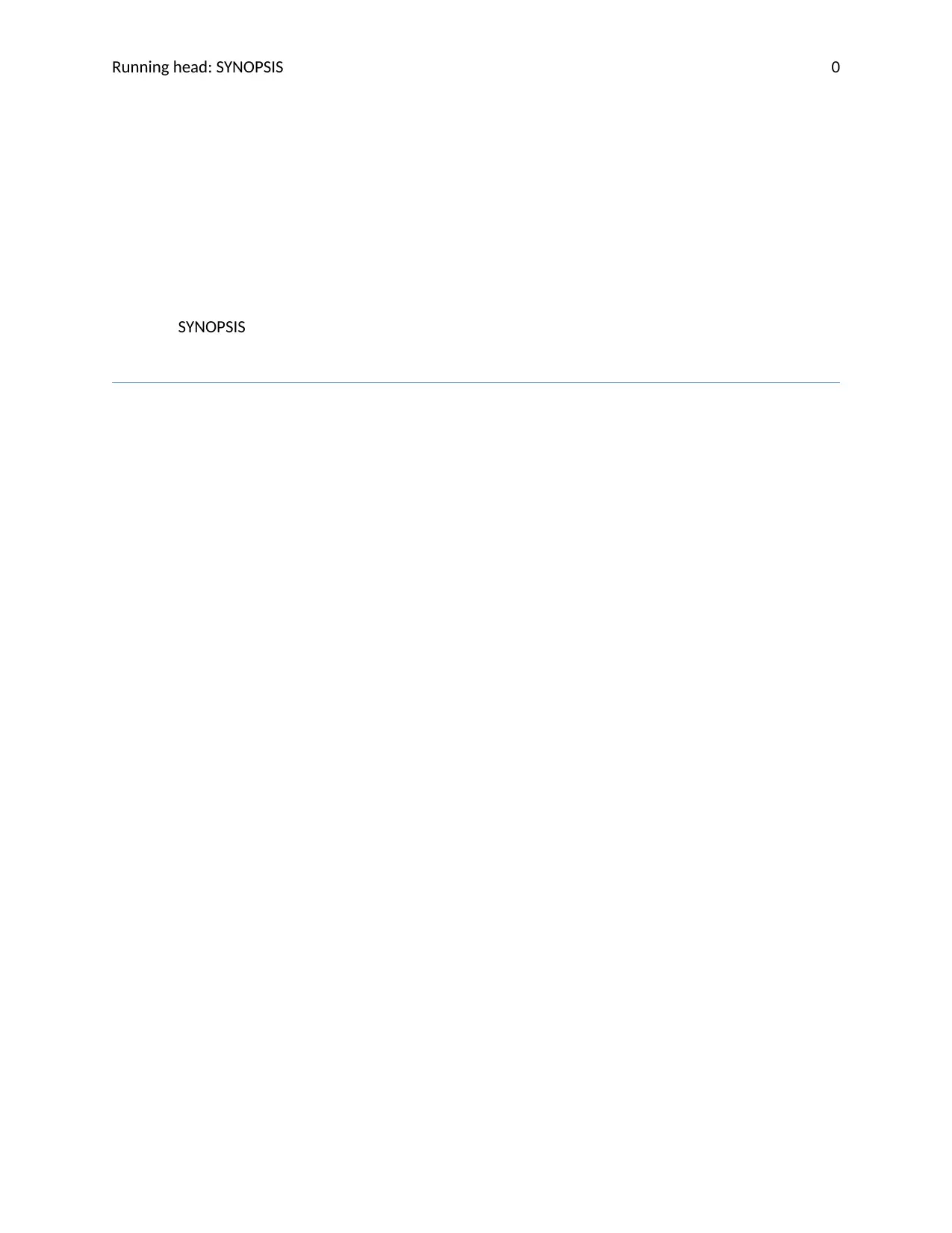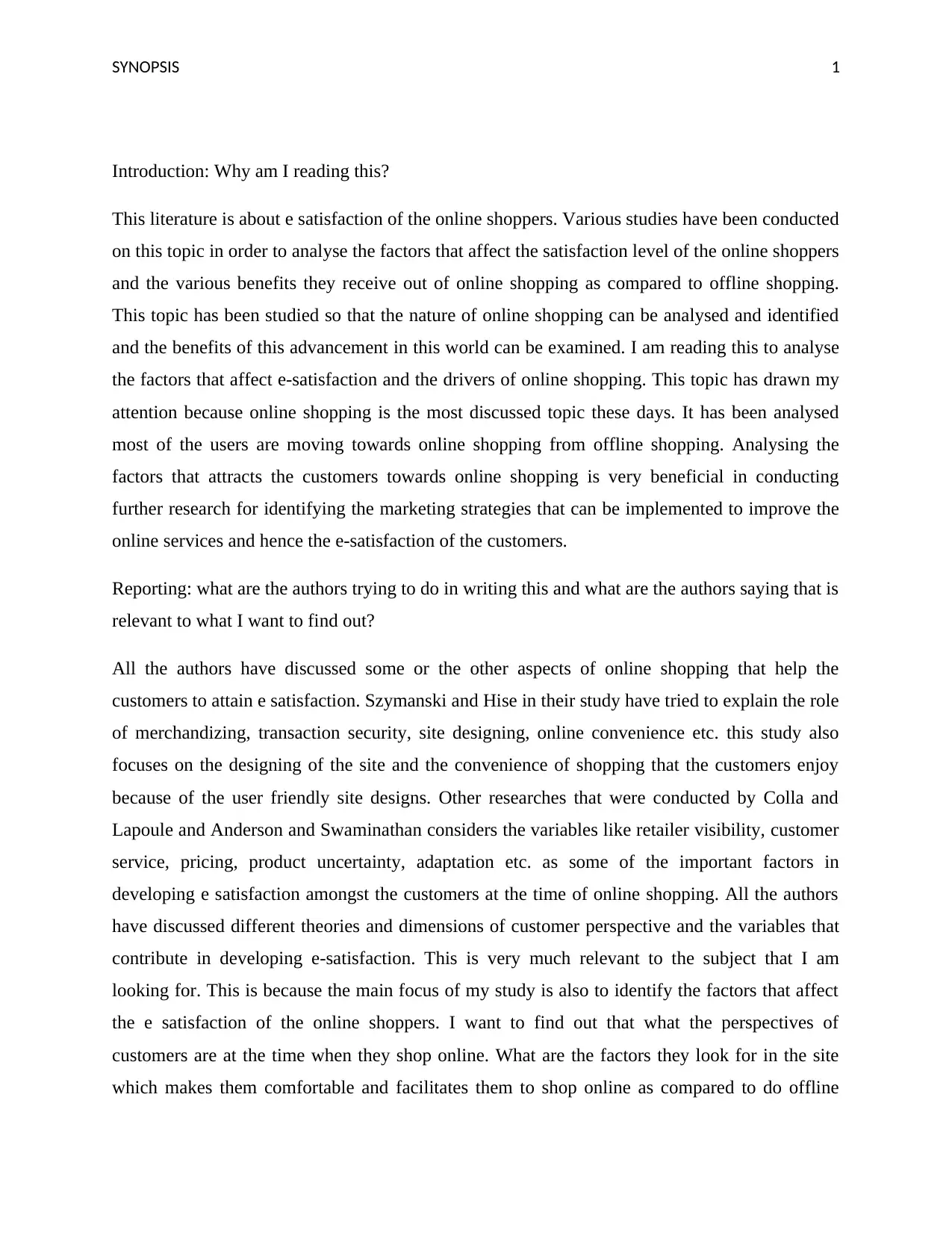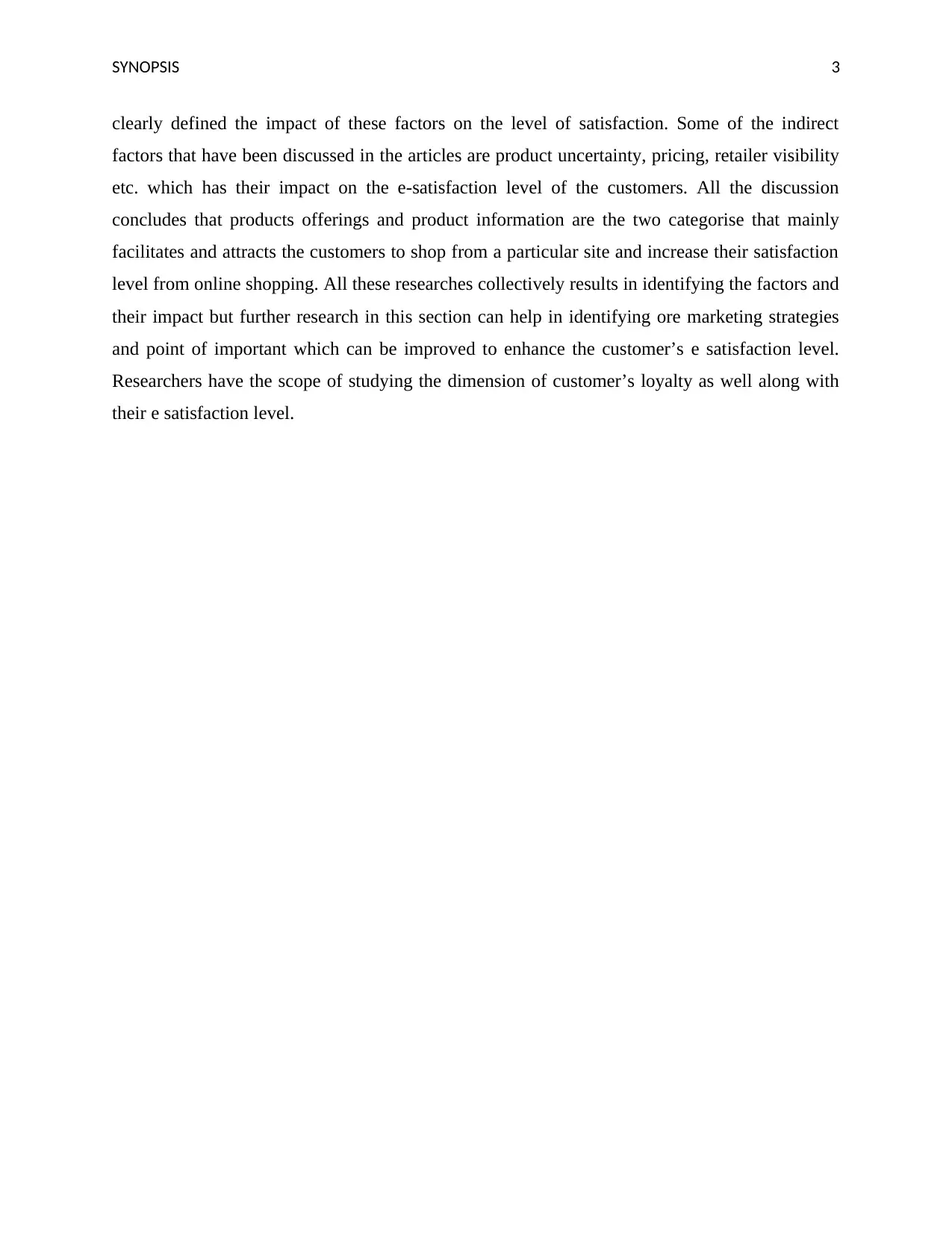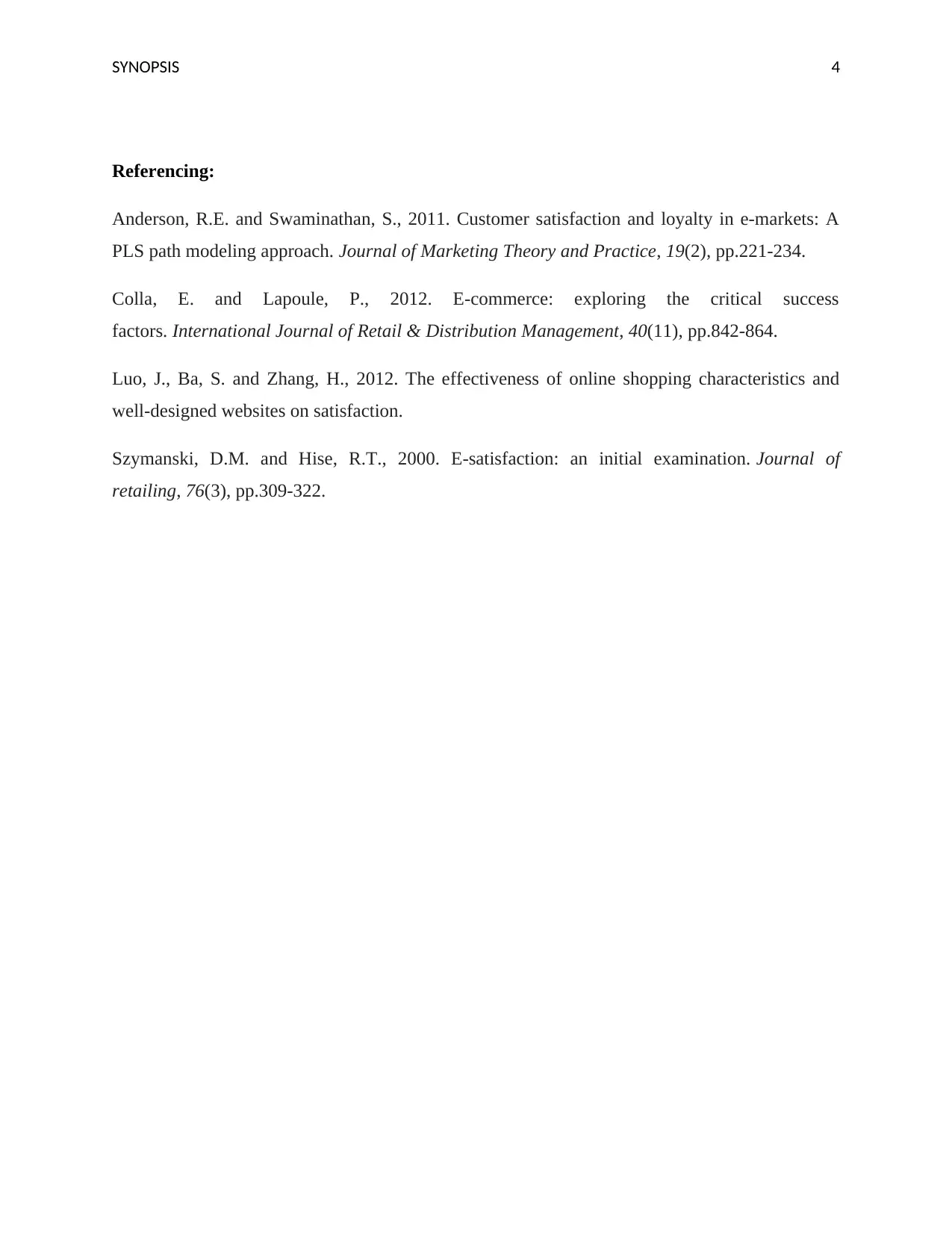Literature Review on E-Satisfaction Factors in Online Shopping
VerifiedAdded on 2020/05/28
|5
|1195
|55
Literature Review
AI Summary
This literature review explores the factors influencing e-satisfaction in online shopping. It examines various studies that analyze the drivers of online shopping and the benefits compared to offline shopping. The review focuses on factors such as merchandising, transaction security, site design, online convenience, retailer visibility, customer service, and pricing. The author synthesizes findings from multiple sources, including studies by Szymanski and Hise, Colla and Lapoule, and Anderson and Swaminathan, to identify key determinants of e-satisfaction. The review highlights the importance of user-friendly site design, product offerings, and product information in enhancing customer satisfaction. The conclusion suggests that e-satisfaction is a complex concept influenced by both direct and indirect factors, emphasizing the potential for further research to improve marketing strategies and enhance customer loyalty. The review also includes a list of cited references.

Running head: SYNOPSIS 0
SYNOPSIS
SYNOPSIS
Paraphrase This Document
Need a fresh take? Get an instant paraphrase of this document with our AI Paraphraser

SYNOPSIS 1
Introduction: Why am I reading this?
This literature is about e satisfaction of the online shoppers. Various studies have been conducted
on this topic in order to analyse the factors that affect the satisfaction level of the online shoppers
and the various benefits they receive out of online shopping as compared to offline shopping.
This topic has been studied so that the nature of online shopping can be analysed and identified
and the benefits of this advancement in this world can be examined. I am reading this to analyse
the factors that affect e-satisfaction and the drivers of online shopping. This topic has drawn my
attention because online shopping is the most discussed topic these days. It has been analysed
most of the users are moving towards online shopping from offline shopping. Analysing the
factors that attracts the customers towards online shopping is very beneficial in conducting
further research for identifying the marketing strategies that can be implemented to improve the
online services and hence the e-satisfaction of the customers.
Reporting: what are the authors trying to do in writing this and what are the authors saying that is
relevant to what I want to find out?
All the authors have discussed some or the other aspects of online shopping that help the
customers to attain e satisfaction. Szymanski and Hise in their study have tried to explain the role
of merchandizing, transaction security, site designing, online convenience etc. this study also
focuses on the designing of the site and the convenience of shopping that the customers enjoy
because of the user friendly site designs. Other researches that were conducted by Colla and
Lapoule and Anderson and Swaminathan considers the variables like retailer visibility, customer
service, pricing, product uncertainty, adaptation etc. as some of the important factors in
developing e satisfaction amongst the customers at the time of online shopping. All the authors
have discussed different theories and dimensions of customer perspective and the variables that
contribute in developing e-satisfaction. This is very much relevant to the subject that I am
looking for. This is because the main focus of my study is also to identify the factors that affect
the e satisfaction of the online shoppers. I want to find out that what the perspectives of
customers are at the time when they shop online. What are the factors they look for in the site
which makes them comfortable and facilitates them to shop online as compared to do offline
Introduction: Why am I reading this?
This literature is about e satisfaction of the online shoppers. Various studies have been conducted
on this topic in order to analyse the factors that affect the satisfaction level of the online shoppers
and the various benefits they receive out of online shopping as compared to offline shopping.
This topic has been studied so that the nature of online shopping can be analysed and identified
and the benefits of this advancement in this world can be examined. I am reading this to analyse
the factors that affect e-satisfaction and the drivers of online shopping. This topic has drawn my
attention because online shopping is the most discussed topic these days. It has been analysed
most of the users are moving towards online shopping from offline shopping. Analysing the
factors that attracts the customers towards online shopping is very beneficial in conducting
further research for identifying the marketing strategies that can be implemented to improve the
online services and hence the e-satisfaction of the customers.
Reporting: what are the authors trying to do in writing this and what are the authors saying that is
relevant to what I want to find out?
All the authors have discussed some or the other aspects of online shopping that help the
customers to attain e satisfaction. Szymanski and Hise in their study have tried to explain the role
of merchandizing, transaction security, site designing, online convenience etc. this study also
focuses on the designing of the site and the convenience of shopping that the customers enjoy
because of the user friendly site designs. Other researches that were conducted by Colla and
Lapoule and Anderson and Swaminathan considers the variables like retailer visibility, customer
service, pricing, product uncertainty, adaptation etc. as some of the important factors in
developing e satisfaction amongst the customers at the time of online shopping. All the authors
have discussed different theories and dimensions of customer perspective and the variables that
contribute in developing e-satisfaction. This is very much relevant to the subject that I am
looking for. This is because the main focus of my study is also to identify the factors that affect
the e satisfaction of the online shoppers. I want to find out that what the perspectives of
customers are at the time when they shop online. What are the factors they look for in the site
which makes them comfortable and facilitates them to shop online as compared to do offline

SYNOPSIS 2
shopping. The articles above discussed have helped me in finding some of the relevant factors
that can affect satisfaction.
Evaluation: how convincing is what the authors are saying?
As far as the study of Szymanski and Hise is considered, it has been analysed that this study has
focussed on roles of some of the variable such as design of the site; merchandising, transactions
security etc. are the determinants of customer e satisfaction. author has also recognized some of
the factors that can affect the positive and negative perspective of the customers on online
shopping such as time saving benefits, browsing benefits, discounts, offers, products assortments
etc. further studies like the study of Colla and Lapoule and Anderson and Swaminathan focuses
on finding some more factors from different dimensions of e satisfaction. Those factors are
visibility of the retailer, pricing, etc. all the studies have the aim of finding some or the other
factors that affect the e satisfaction of the customers when they shop online. It is very much
convincing what Szymanski and Hise has said because the factors they have discussed are very
much linked and directly affect the e satisfaction level of the customers but as far as the study of
Luo et al. discussed about the indirect dimensions and variables that can have their impact on e-
satisfaction. If another perspective have been analysed then it has been identified that studying
the indirect factors is also necessary for understanding every aspect of the topic. According to
me studying both types of factors is necessary and thus it is required to have a greater and wider
view of the topic. All the articles in the literature are convincing and made the theories that are
very much relevant to the topic of study and thus convince me to consider these theories for my
research. Understanding the dimensions of these articles has given me a different thinking
Conclusion: what use can I make of this?
The discussion of all these articles suggests that e-satisfaction can be defined as the degree of
satisfaction the customers have at the time of doing online shopping. This e satisfaction is
affected by many direct and indirect factors. Some of the direct factors that have been discussed
in these articles are design of the site, transaction security etc. design of the site matters a lot as
this is the major thing that attracts and facilitate the user to use the site and conduct the shopping
activities. If the site is not designed properly is not user friendly then it may affect the
satisfaction level of the customer. The model that is called as four cubed conceptual model has
shopping. The articles above discussed have helped me in finding some of the relevant factors
that can affect satisfaction.
Evaluation: how convincing is what the authors are saying?
As far as the study of Szymanski and Hise is considered, it has been analysed that this study has
focussed on roles of some of the variable such as design of the site; merchandising, transactions
security etc. are the determinants of customer e satisfaction. author has also recognized some of
the factors that can affect the positive and negative perspective of the customers on online
shopping such as time saving benefits, browsing benefits, discounts, offers, products assortments
etc. further studies like the study of Colla and Lapoule and Anderson and Swaminathan focuses
on finding some more factors from different dimensions of e satisfaction. Those factors are
visibility of the retailer, pricing, etc. all the studies have the aim of finding some or the other
factors that affect the e satisfaction of the customers when they shop online. It is very much
convincing what Szymanski and Hise has said because the factors they have discussed are very
much linked and directly affect the e satisfaction level of the customers but as far as the study of
Luo et al. discussed about the indirect dimensions and variables that can have their impact on e-
satisfaction. If another perspective have been analysed then it has been identified that studying
the indirect factors is also necessary for understanding every aspect of the topic. According to
me studying both types of factors is necessary and thus it is required to have a greater and wider
view of the topic. All the articles in the literature are convincing and made the theories that are
very much relevant to the topic of study and thus convince me to consider these theories for my
research. Understanding the dimensions of these articles has given me a different thinking
Conclusion: what use can I make of this?
The discussion of all these articles suggests that e-satisfaction can be defined as the degree of
satisfaction the customers have at the time of doing online shopping. This e satisfaction is
affected by many direct and indirect factors. Some of the direct factors that have been discussed
in these articles are design of the site, transaction security etc. design of the site matters a lot as
this is the major thing that attracts and facilitate the user to use the site and conduct the shopping
activities. If the site is not designed properly is not user friendly then it may affect the
satisfaction level of the customer. The model that is called as four cubed conceptual model has
⊘ This is a preview!⊘
Do you want full access?
Subscribe today to unlock all pages.

Trusted by 1+ million students worldwide

SYNOPSIS 3
clearly defined the impact of these factors on the level of satisfaction. Some of the indirect
factors that have been discussed in the articles are product uncertainty, pricing, retailer visibility
etc. which has their impact on the e-satisfaction level of the customers. All the discussion
concludes that products offerings and product information are the two categorise that mainly
facilitates and attracts the customers to shop from a particular site and increase their satisfaction
level from online shopping. All these researches collectively results in identifying the factors and
their impact but further research in this section can help in identifying ore marketing strategies
and point of important which can be improved to enhance the customer’s e satisfaction level.
Researchers have the scope of studying the dimension of customer’s loyalty as well along with
their e satisfaction level.
clearly defined the impact of these factors on the level of satisfaction. Some of the indirect
factors that have been discussed in the articles are product uncertainty, pricing, retailer visibility
etc. which has their impact on the e-satisfaction level of the customers. All the discussion
concludes that products offerings and product information are the two categorise that mainly
facilitates and attracts the customers to shop from a particular site and increase their satisfaction
level from online shopping. All these researches collectively results in identifying the factors and
their impact but further research in this section can help in identifying ore marketing strategies
and point of important which can be improved to enhance the customer’s e satisfaction level.
Researchers have the scope of studying the dimension of customer’s loyalty as well along with
their e satisfaction level.
Paraphrase This Document
Need a fresh take? Get an instant paraphrase of this document with our AI Paraphraser

SYNOPSIS 4
Referencing:
Anderson, R.E. and Swaminathan, S., 2011. Customer satisfaction and loyalty in e-markets: A
PLS path modeling approach. Journal of Marketing Theory and Practice, 19(2), pp.221-234.
Colla, E. and Lapoule, P., 2012. E-commerce: exploring the critical success
factors. International Journal of Retail & Distribution Management, 40(11), pp.842-864.
Luo, J., Ba, S. and Zhang, H., 2012. The effectiveness of online shopping characteristics and
well-designed websites on satisfaction.
Szymanski, D.M. and Hise, R.T., 2000. E-satisfaction: an initial examination. Journal of
retailing, 76(3), pp.309-322.
Referencing:
Anderson, R.E. and Swaminathan, S., 2011. Customer satisfaction and loyalty in e-markets: A
PLS path modeling approach. Journal of Marketing Theory and Practice, 19(2), pp.221-234.
Colla, E. and Lapoule, P., 2012. E-commerce: exploring the critical success
factors. International Journal of Retail & Distribution Management, 40(11), pp.842-864.
Luo, J., Ba, S. and Zhang, H., 2012. The effectiveness of online shopping characteristics and
well-designed websites on satisfaction.
Szymanski, D.M. and Hise, R.T., 2000. E-satisfaction: an initial examination. Journal of
retailing, 76(3), pp.309-322.
1 out of 5
Related Documents
Your All-in-One AI-Powered Toolkit for Academic Success.
+13062052269
info@desklib.com
Available 24*7 on WhatsApp / Email
![[object Object]](/_next/static/media/star-bottom.7253800d.svg)
Unlock your academic potential
Copyright © 2020–2025 A2Z Services. All Rights Reserved. Developed and managed by ZUCOL.





